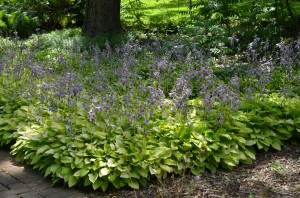Hostas are the most popular shade perennial in the U.S. They prefer a moist, compost-rich, well-drained soil. In northerly areas (USDA hardiness zones 4-5), where summers are cooler, most hardy cultivars grow in full sun. In warmer zones those in full sun must be irrigated frequently.
Blue leaf cultivars look their best only in shady areas; the white waxy coating, responsible for their bluish foliage color, melts off quickly under high light. By late summer most of the leaf wax has weathered away even under shade.
While mostly free of diseases and pests, many cultivars are susceptible to foliar injury from slugs and snails. Deer are also a serious menace.
Hostas should be divided every 5 -6 years, usually in the early spring when emerging shoots poke through the ground or in early autumn as leaves decline. Exact timing is not critical. Dig up the entire clump and divide with a sharp knife. Each division should contain at least 3 eyes (growing points).
In frigid northern areas, hostas should be mulched with a layer of finely shredded organic material to prevent frost heaving, particularly newly divided plants. Mulch is also reduces soil moisture evaporation; unfortunately it serves as an an ideal home for slugs.
Holes in leaf centers are a symptom that snails and slugs are present. Apply a commercial slug bait in early spring as shoots emerge to reduce their numbers. In the fall rake up and dispose off (do not compost) all hosta foliage to reduce slug and leaf-eating insect populations.
Depending on cultivar hosta’s funnel-shaped white or purple flowers arise equal to or several inches above the foliage. Yes, flowers are fragrant, but their scent is rarely overwhelming unless a fragrant cultivar is present in large numbers.
American Hosta Growers Organization offers different sizing standards for cultivars for the North and South*:
Type North South
Mini Up to 8 inches Up to 7 inches
Small 9-14 inches 8-11 inches
Medium 15-22 inches 12-18 inches
Large 23-29 inches 19-24 inches
Giant 30 inches and above 25 inches and above
* Interstate 80 divides the U.S. horizontally using North (above I-80) and South (below I-80)
Below Interstate 40 designated for the South. The area between these two Highways is designated Middle.


 Posted in
Posted in 

Thank you Hugh, for the Hosta information. Those who want to learn even more about Hostas should know that the 2015 National Hosta Society Convention will be held in Raleigh, N.C. June 18-20, 2015. Hosta plant and leaf judging,visits to some beautiful area gardens and nurseries will take place. You must be a member of the national American Hosta Society to attend. americanhostasociety.org
PS Anyone interested in carpooling can send me a Message on Facebook.